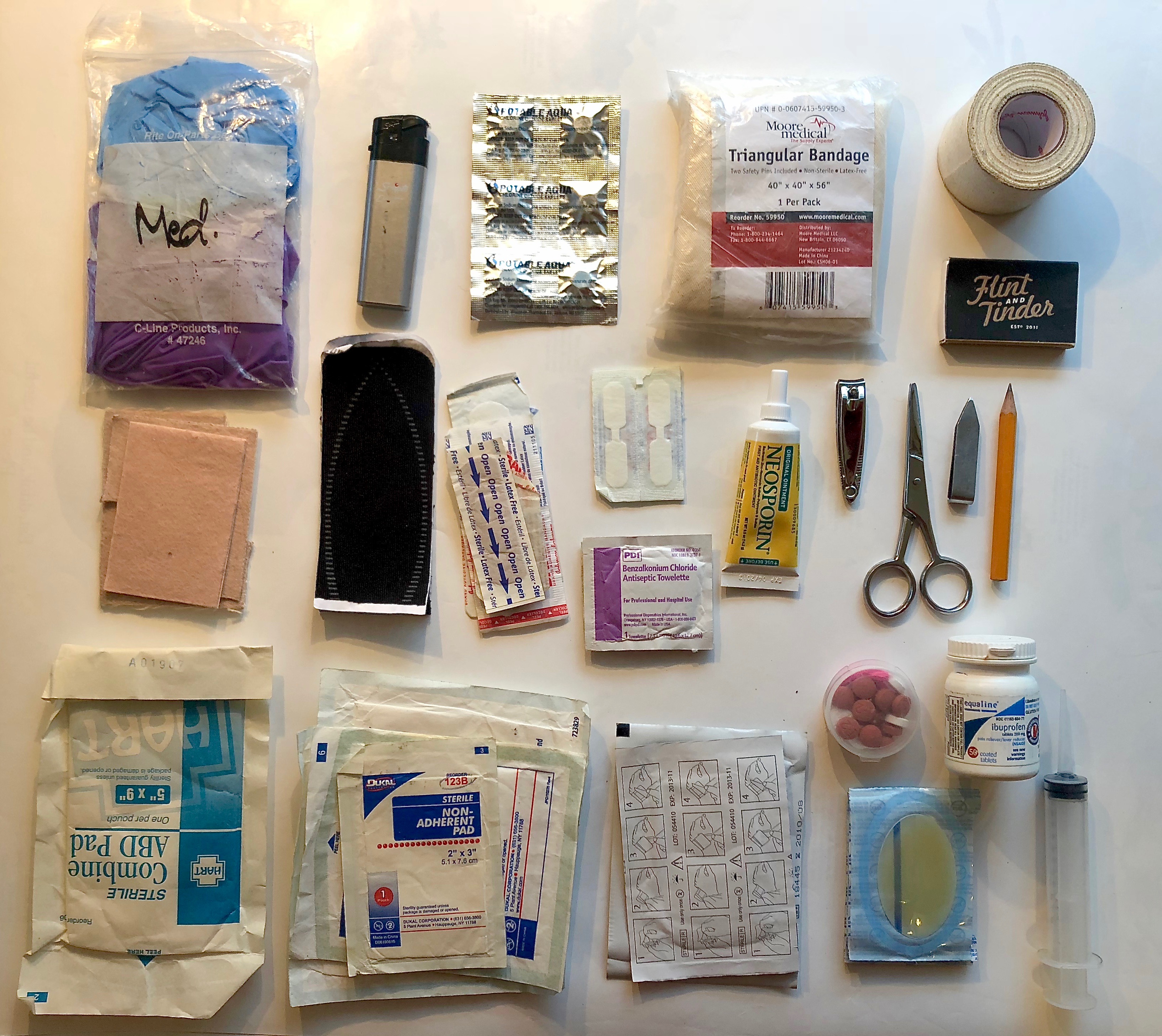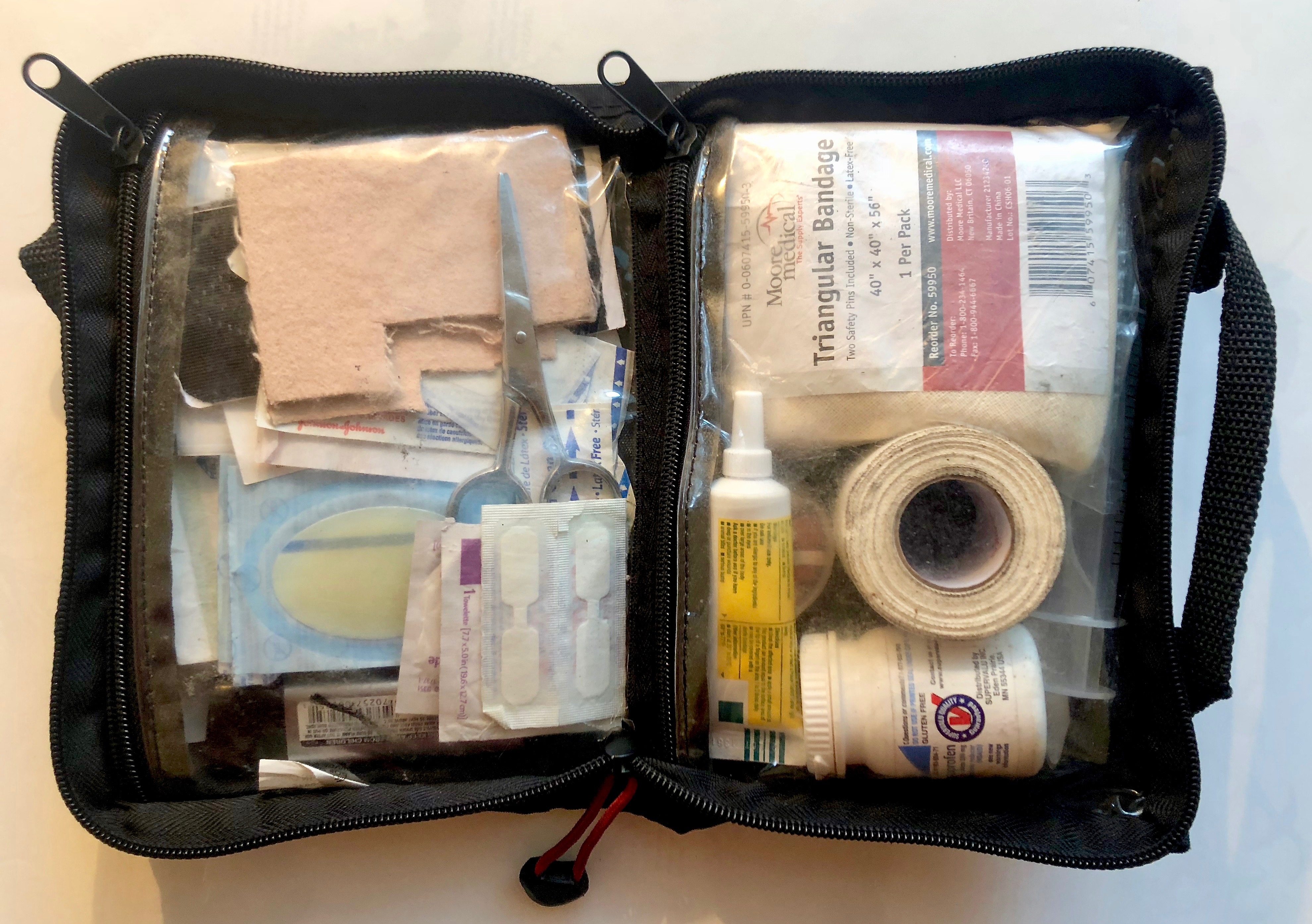Outside magazine had an excellent article in September 2018 about How to Build a Proper First-Aid Kit that started me thinking about sharing my own personal approach to wilderness first aid kits. The article was published shortly after I finished leading a backpacking trip for 9 college students, where I had to build a complete group first aid kit from scratch, so much of my decision making process was still fresh in my mind.
Having been a Wilderness First Responder since 2002 and formerly a Wilderness EMT for four years, I have definitely been well trained to handle medical emergencies in the backcountry. Any article worth its salt will remind you that the most important tool is the one between your ears. There is a time commitment, but if you are at all serious about the outdoors, I cannot emphasize enough how highly I recommend becoming a Wilderness First Responder through organizations like WMI (NOLS), WMAI, and SOLO. Their training will not only give you medical knowledge and the experience to use it, but also the ability to manage risk and lead a group effectively if things ever take a bad turn.
Your first aid kit is a product of your expectations and experiences. As time goes on, an individual will settle on the kit that will best work for them and their activities. And, if you build and stock your own, you can tweak what you carry for every trip. Ready-made first aid kits are handy when you are first starting out but as you buy new supplies, store the extras at home in a dry container to make resupply and tweaks easier. It is also never a bad idea to have extra first aid supplies at home, just in case a natural disaster occurs.
All of my experience has led me to breaking my first aid kits up into three categories. One where it is just me and I am going ultralight. One where I am trying to reasonably accommodate common injuries for a small group of friends. And finally, when I am leading a group into the wilderness and am the responsible party for everyone’s health and safety.
Fast and Ultralight Kit
Purpose: Personal trips like ultralight backpacking, backcountry trail runs, or long distance bike rides–when your most likely concerns will be blisters, small bleeds, and pain relief and when you want to go light.
- Medications. Small pill container with ibuprofen, acetaminophen, and antihistamine (Benadryl).
- 2 to 3 blister pads
- 2 gauze pads
- Wound closure strips
- Athletic tape
- Antiseptic towelettes
- Chlorine dioxide tablets
- Lighter
- Small tweezers
For medications, many people will also bring aspirin and an antidiarrheal. I do not take aspirin and in all of my years I have never needed an antidiarrheal, so for my personal trips I will not take either. I will also not take a pair of scissors, which means I cannot trim my gauze and will need to use the small tweezers to help drain blisters. Those are acceptable compromises for me. The chlorine dioxide tablets are meant to be a backup in case my Aqua Mira goes missing or I run out of water on a bike ride; both of which have happened to me.
This first aid kit is so light that it can easily fit into a heavy duty ziplock sandwich bag and its weight is inconsequential.
Multi-Purpose Kit: Hiking, Climbing, and Camping Trips
Purpose: Trips closer to civilization (where weight is less of a concern) and when I am not going out alone. It is my standard multi-purpose first aid kit that handles numerous use cases and activities. If I am not leading a group and not doing an ultralight trip, this is what I grab.


- Medications. Pill container with ibuprofen, acetaminophen, and antihistamine (Benadryl).
- Other Meds: Small, single use packets with chewable aspirin and antidiarrheal.
- 4 to 5 blister pads
- Moleskin, both thin and thick
- KT Tape for blister hot spots
- Callous cushions. For protecting small blisters.
- Bandaids of various sizes and purposes (ex: knuckle + finger bandaids for climbing)
- 4 or 5 gauze pads of varying sizes
- Wound closure strips.
- Athletic tape
- Antiseptic towelettes and/or hand sanitizer
- Irrigation syringe
- Antibiotic cream, squeeze tube
- Chlorine dioxide tablets
- Lighter
- Matches
- Sewing needle for blisters
- 2+ pairs of nitrile gloves
- Small scissors
- Small tweezers
- Finger nail clippers
- Triangle bandage with safety pins
- Climbing salve (for feet and hands)
This is obviously a more substantial first aid kit. Serious bleeds can be handled and wounds well cleaned. The materials may have to last for 2-3 days and handle multiple, separate injuries as well. I also start including additional medications for more varied scenarios—chewable aspirin, for instance, may be indicated for a myocardial infarction patient.
This kit should be well organized so you can find things without any fuss. My materials go into a first aid bag that has a thin pocket on the outside for two pairs of nitrile gloves and then the bag unzips completely to lay flat on the ground with two inner pouches with clear plastic where everything is easy to see and retrieve. It’s approximate weight is 1.5 pounds.
Group Kit: The Whole Shebang
Purpose: You are the person responsible for first aid on a group trip. This is the kit that I will most customize to the activity of the trip and will often create a surplus of certain supplies to handle the most likely injuries or illnesses. For example, if three people get blisters on a backpacking trip, it is incredible how quickly your blister supplies will dwindle, so I will easily double or triple blister treatments on such a trip. Also, when leading these manner of trips, I will usually create a much smaller, personal first aid kit for myself and keep it separate.
- Pain relief. Ibuprofen and acetaminophen in sufficient quantities and in a dedicated plastic bag or container.
- Other Medications. Single use packets or clearly labeled ziplocks for antihistamine (Benadryl), aspirin, and antidiarrheal.
- 6-8 blister pads
- Moleskin, both thin and thick
- Callous cushions. For protecting small blisters these work great.
- Bandaids of various sizes and purposes (ex: knuckle + finger bandaids for climbing)
- 4 or 5 medium gauze pads
- 3 or 4 large gauze pads
- Maxi pad, for larger bleeds
- Tampon. Handy for nose bleeds and as backup for female participants.
- Israeli/emergency bandage, for really serious bleeds.
- Wound closure kit with transparent semi-permeable dressing
- Athletic tape
- Antiseptic towelettes
- Hand sanitizer, small bottle.
- Irrigation syringe
- Antibiotic cream, squeeze tube
- Burn gel or second skin
- Povidone-iodine solution (packets or small bottle)
- Chlorine dioxide tablets
- Lighter/Matches
- Sewing needle for blisters
- 3+ pairs of nitrile gloves
- Trauma sheers
- Small tweezers
- Finger nail clippers
- 2-3 triangle bandages with safety pins
- Pencil + SOAP notes
- Thermometer
- CPR mask or face shield
- SAM splint
- Elastic wrap, aka Ace bandage
- Epinephrine injection (EpiPen)
- Cavit
- Glucose tabs or paste x 2
This is a fairly heavy kit and will always be near the top of my pack for easy access. It also assumes you have the training to use it. The person carrying this kit should be a Wilderness First Responder with a current CPR certification. My only persistent hiccup with this kit is how quickly you can get into a game of “What if?” with yourself and start packing as if you are supplying a field hospital. This is where training and past experience comes in handy. Rely on that.
This first aid kit is usually broken up into labeled ziplock bags all contained within a larger sack or organizing pack/pouch. Organization is key for this size kit, so do not skimp organizing both before every single trip and after every use. If taking a large group (more than 3 people), consider breaking this kit up into two separate kits so someone else can carry part of the load and all of your eggs are not in one basket. The weight of this first aid kit will easily be three pounds or more.
Additional Items
- Benzoin tincture - Every single WFR course I have taken loves to espouse the benefits of this substance. Unless it comes within a wound closure kit, I never bring it. It has never been effective enough for me to justify its inclusion in my first aid kits.
- Self-adherent tape (Coban) - It does not adhere to skin/hair and is lightweight, porous, water-resistant, and breathable. Also is stretchy so it will help provide compression, if necessary. Typically contains latex, which may cause an allergic reaction in some people. If it is provided by an organization, I will put it in a group first aid kit.
- Leukotape P - Have yet to try this tape for blisters, but it comes highly recommend by Andrew Skurka so I will likely try it out on a backpacking or backcountry ski trip soon.
- Duct Tape - I never ever use this for blisters or wound care. I will bring a few meters of it in my repair kit, but in my opinion it does not belong in a medical situation.
- Super Glue - I never ever use this for blisters or wound care. I will bring a small tube of it in my repair kit, but in my opinion it does not belong in a medical situation.
- Knives - I do not put a knife in my first aid kits. A solid pair of scissors or trauma sheers is all I have ever needed and it is hard to fathom a backcountry situation where I would use a knife within the context of medical treatment. That being said, I normally have a lightweight pocket knife or multi-tool on me at all times and it could be useful when constructing a splint or litter in the backcountry.
- Oral Rehydration Salts - If I was traveling in another country where diarrhea in travelers was common, I would definitely bring some in a group first aid kit. Have yet to bring or need this on any of my trips in North America.